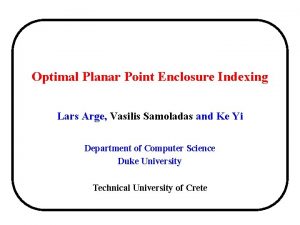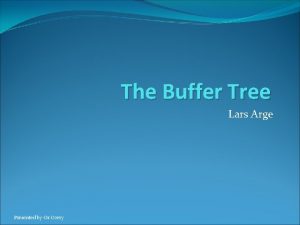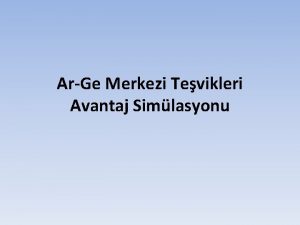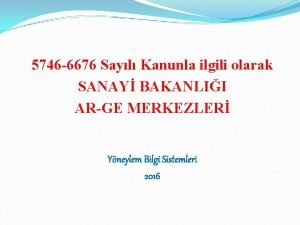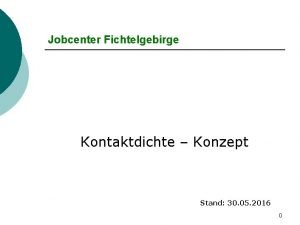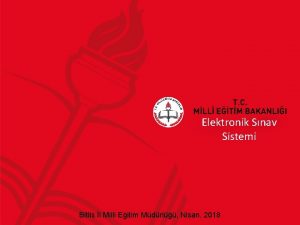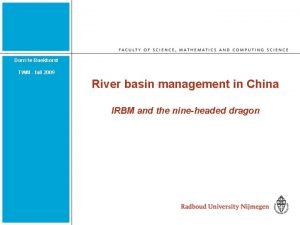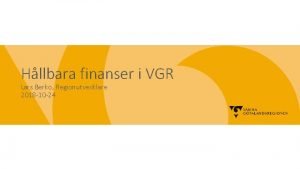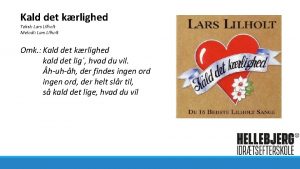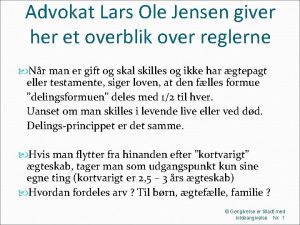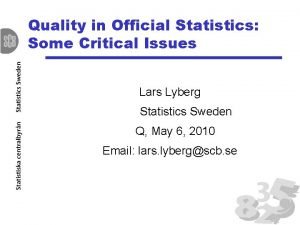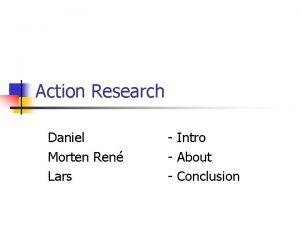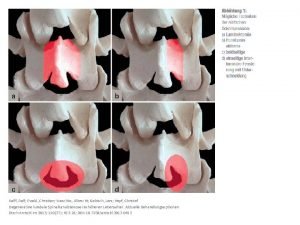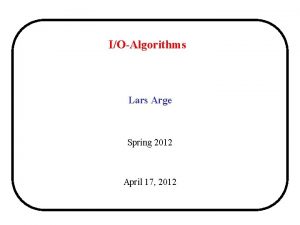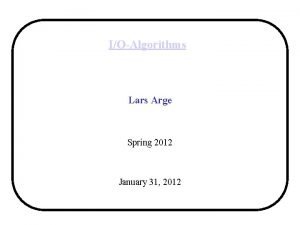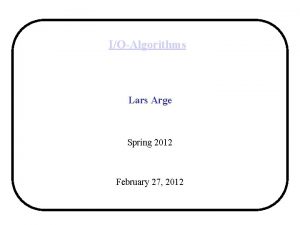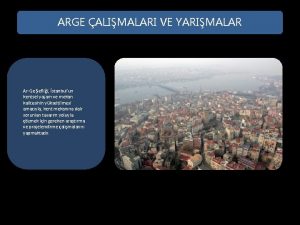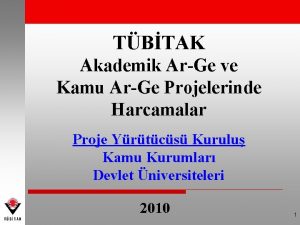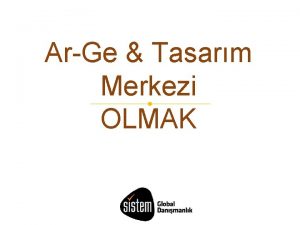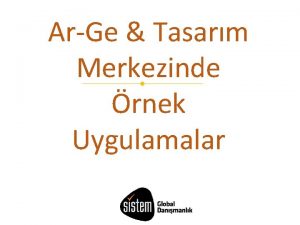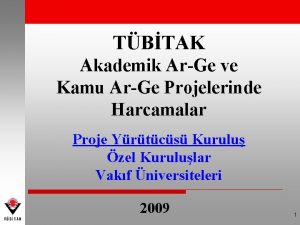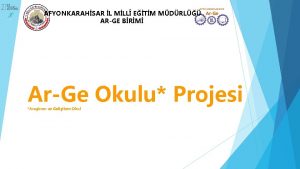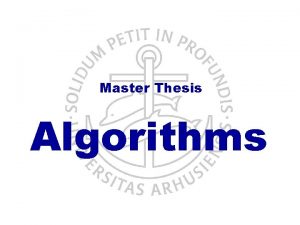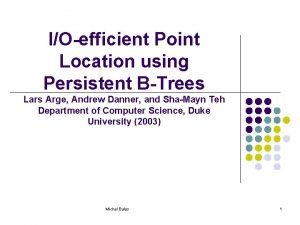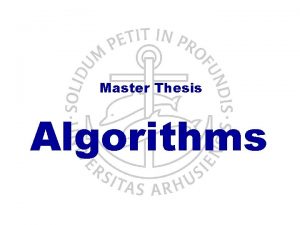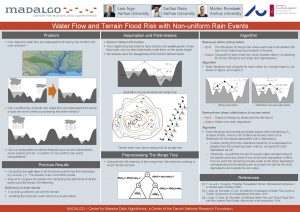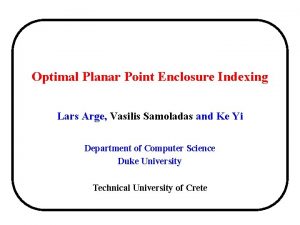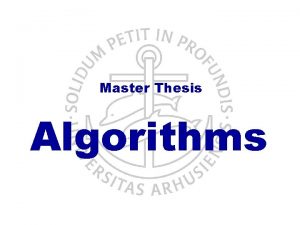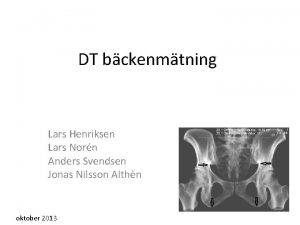IOAlgorithms Lars Arge Fall 2014 August 28 2014




























- Slides: 28

I/O-Algorithms Lars Arge Fall 2014 August 28, 2014

I/O-Algorithms Massive Data • Pervasive use of computers and sensors • Increased ability to acquire/store/process data → Massive data collected everywhere • Society increasingly “data driven” → Access/process data anywhere any time Obviously not only in sciences: Nature/Science special issues • • Economist 02/10: 2/06, 9/08, 2/11 • From 150 Billion Gigabytesexponentially, five years ago • Scientific data size growing to 1200 Billion while quality andtoday availability improving • Managing data deluge difficult; doing so • Paradigm shift: Science will be about mining data will transform business/public life Lars Arge 2

I/O-Algorithms Massive Data • What happens in an internet minute? Lars Arge 3

I/O-Algorithms Example: Grid Terrain Data • Appalachian Mountains (800 km x 800 km) – 100 m resolution ~ 64 M cells ~128 MB raw data (~500 MB when processing) – ~ 1. 2 GB at 30 m resolution NASA SRTM mission acquired 30 m data for 80% of the earth land mass – ~ 12 GB at 10 m resolution (US available from USGS) – ~ 1. 2 TB at 1 m resolution (quickly becoming available) – …. 10 -100 points per m 2 already possible Lars Arge 4

I/O-Algorithms Example: LIDAR Terrain Data • Massive (irregular) point sets (~1 m resolution) – Becoming relatively cheap and easy to collect • Sub-meter resolution using mobile mapping Lars Arge 5

I/O-Algorithms Example: LIDAR Terrain Data • COWI A/S (and others) have scanned Denmark ~1, 2 km ~ 1, 5 m be tween measurem ents ~ 280 km/h at 1500 -2000 m Lars Arge 6

I/O-Algorithms Example: LIDAR Terrain Data • • ~2 million points at 30 meter (<1 GB) ~18 billion points at 1 meter (>1 TB) Lars Arge 7

I/O-Algorithms Application Example: Flooding Prediction +1 meter +2 meter Lars Arge 8

I/O-Algorithms Example: Detailed Data Essential • Mandø with 2 meter sea-level raise 80 meter terrain model Lars Arge 2 meter terrain model 9

I/O-Algorithms Random Access Machine Model R A M • Standard theoretical model of computation: – Infinite memory – Uniform access cost • Simple model crucial for success of computer industry Lars Arge 10

I/O-Algorithms Hierarchical Memory L 1 L 2 R A M • Modern machines have complicated memory hierarchy – Levels get larger and slower further away from CPU – Data moved between levels using large blocks Lars Arge 11

I/O-Algorithms Slow I/O • Disk access is 106 times slower than main memory access track read/write head read/write arm “The difference in speed between modern CPU and disk technologies is analogous to the difference in speed in sharpening a pencil using a sharpener on one’s magnetic surface desk or by taking an airplane to the other side of the world – Disk systems try to amortize large accessand time transferring largeon using a sharpener contiguous blocks of data someone else’s desk. ” (D. • Important to store/access data to take advantage of blocks (locality) Comer) Lars Arge 12

I/O-Algorithms Scalability Problems • Most programs developed in RAM-model – Run on large datasets because OS moves blocks as needed Scalability problems! running time • Moderns OS utilizes sophisticated paging and prefetching strategies – But if program makes scattered accesses even good OS cannot take advantage of block access data size Lars Arge 13

I/O-Algorithms External Memory Model D Block I/O N = # of items in the problem instance B = # of items per disk block M = # of items that fit in main memory T = # of items in output M P Lars Arge I/O: Move block between memory and disk We assume (for convenience) that M >B 2 14

I/O-Algorithms Fundamental Bounds • • Scanning: Sorting: Permuting Searching: Internal N N log N External • Note: – Linear I/O: O(N/B) – Permuting not linear – Permuting and sorting bounds are equal in all practical cases – B factor VERY important: – Cannot sort optimally with search tree Lars Arge 15

I/O-Algorithms Scalability Problems: Block Access Matters • Example: Traversing linked list (List ranking) – Array size N = 10 elements – Disk block size B = 2 elements – Main memory size M = 4 elements (2 blocks) 1 5 2 6 3 8 9 4 7 10 Algorithm 1: N=10 I/Os 1 2 10 9 5 6 3 4 8 7 Algorithm 2: N/B=5 I/Os • Large difference between N and N/B large since block size is large – Example: N = 256 x 106, B = 8000 , 1 ms disk access time N I/Os take 256 x 103 sec = 4266 min = 71 hr N/B I/Os take 256/8 sec = 32 sec Lars Arge 16

I/O-Algorithms Queues and Stacks • Queue: – Maintain push and pop blocks in main memory Push Pop O(1/B) Push/Pop operations • Stack: – Maintain push/pop blocks in main memory O(1/B) Push/Pop operations Lars Arge 17

I/O-Algorithms Sorting • <M/B sorted lists (queues) can be merged in O(N/B) I/Os M/B blocks in main memory • Unsorted list (queue) can be distributed using <M/B split elements in O(N/B) I/Os Lars Arge 18

I/O-Algorithms Sorting • Merge sort: – Create N/M memory sized sorted lists – Repeatedly merge lists together Θ(M/B) at a time Lars Arge phases using I/Os each I/Os 19

I/O-Algorithms Sorting • Distribution sort (multiway quicksort): – Compute Θ(M/B) splitting elements – Distribute unsorted list into Θ(M/B) unsorted lists of equal size – Recursively split lists until fit in memory Lars Arge phases I/Os if splitting elements computed in O(N/B) I/Os 20

I/O-Algorithms Computing Splitting Elements • In internal memory (deterministic) quicksort split element (median) found using linear time selection • Selection algorithm: Finding i’th element in sorted order 1) Select median of every group of 5 elements 2) Recursively select median of ~ N/5 selected elements 3) Distribute elements into two lists using computed median 4) Recursively select in one of two lists • Analysis: – Step 1 and 3 performed in O(N/B) I/Os. – Step 4 recursion on at most ~ elements I/Os Lars Arge 21

I/O-Algorithms Sorting • Distribution sort (multiway quicksort): • Computing splitting elements: – Θ(M/B) times linear I/O selection O(NM/B 2) I/O algorithm – But can use selection algorithm to compute splitting elements in O(N/B) I/Os, partitioning into lists of size < phases algorithm Lars Arge 22

I/O-Algorithms Computing Splitting Elements 1) Sample elements: – Create N/M memory sized sorted lists – Pick every ’th element from each sorted list 2) Choose split elements from sample: – Use selection algorithm times to find every ’th element • Analysis: – Step 1 performed in O(N/B) I/Os – Step 2 performed in O(N/B) I/Os Lars Arge I/Os 23

I/O-Algorithms Computing Splitting Elements 1) Sample elements: – Create N/M memory sized sorted lists – Pick every ’th element from each sorted list 2) Choose split elements from sample: – Use selection algorithm times to find every ’th element sampled elements Lars Arge 24

I/O-Algorithms Computing Splitting Elements • Elements in range R defined by consecutive split elements – Sampled elements in R: – Between sampled element in R and outside R: sampled elements Lars Arge 25

I/O-Algorithms Summary/Conclusion: Sorting • External merge or distribution sort takes – Merge-sort based on M/B-way merging – Distribution sort based on -way distribution and partition elements finding I/Os • Optimal – As we will prove next time Lars Arge 26

I/O-Algorithms References • Input/Output Complexity of Sorting and Related Problems A. Aggarwal and J. S. Vitter. CACM 31(9), 1998 • External partition element finding Lecture notes by L. Arge and M. G. Lagoudakis. Lars Arge 27

I/O-Algorithms Project 1: Implementation of Merge Sort Lars Arge 28
 Lars arge
Lars arge Lars arge
Lars arge Mehmet emin karamehmet kimdir
Mehmet emin karamehmet kimdir Arge merkezi avantajları
Arge merkezi avantajları Arge twm
Arge twm Teknokent muhasebe kayıtları örnekleri
Teknokent muhasebe kayıtları örnekleri Attila özgit
Attila özgit Arge merkezi dışarıda geçirilen süreler
Arge merkezi dışarıda geçirilen süreler Kontaktdichte
Kontaktdichte Bitlis arge.meb.gov.tr/esinav
Bitlis arge.meb.gov.tr/esinav Arge twm
Arge twm Lars cleijne
Lars cleijne Kraigher kristofferson
Kraigher kristofferson Lars perkins
Lars perkins Lars berko
Lars berko Kald det kærlighed tekst
Kald det kærlighed tekst Lars wøldike
Lars wøldike Tvangsarv 1/16
Tvangsarv 1/16 Lars bruflat
Lars bruflat Lars wallrup
Lars wallrup Lars lyberg
Lars lyberg Lars kjerulf petersen
Lars kjerulf petersen Lars bo kaspersen
Lars bo kaspersen Lars intro
Lars intro Hälsokedjan
Hälsokedjan Jens elmelund
Jens elmelund Lars jonsson uppsala
Lars jonsson uppsala Lars wiig
Lars wiig Foramenokklusionsschmerz
Foramenokklusionsschmerz
